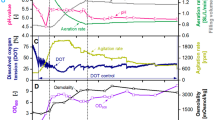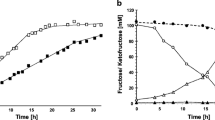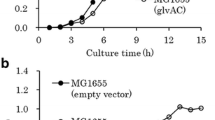Abstract
Most Saccharomyces spp. cannot degrade or ferment dextrin, which is the second most abundant carbohydrate in wort for commercial beer production. Dextrin-degrading brewer’s bottom and top yeasts expressing the glucoamylase gene (GAM1) from Debaryomyces occidentalis were developed to produce low-carbohydrate (calorie) beers. GAM1 was constitutively expressed in brewer’s yeasts using a rDNA-integration system that contained yeast CUP1 gene coding for copper resistance as a selective marker. The recombinants secreted active glucoamylase, displaying both α-1,4- and α-1,6-debranching activities, that degraded dextrin and isomaltose and consequently grew using them as sole carbon source. One of the recombinant strains expressing GAM1 hydrolyzed 96 % of 2 % (w/v) dextrin and 98 % of 2 % (w/v) isomaltose within 5 days of growth. Growth, substrate assimilation, and enzyme activity of these strains were characterized.




Similar content being viewed by others
References
Dohmen RJ, Strasser AWM, Dahlems UM, Hollenberg CP (1990) Cloning of the Schwanniomyces occidentalis glucoamylase gene (GAM1) and its expression in Saccharomyces cerevisiae. Gene 95:111–121
Domingues L, Onnela ML, Teixeira JA, Lima N, Penttila M (2000) Construction of a flocculent brewer’s yeast strain secreting Aspergillus niger β-galactosidase. Appl Microbiol Biotechnol 54:97–103
Gietz D, St. Jean A, Woods R, Schiestl RH (1992) Improved method for high efficiency transformation of intact yeast cells. Nucleic Acids Res 20:1425
Hansen M, Rocken W, Emeis CC (1990) Construction of yeast strains for the production of low-carbohydrate beer. J Inst Brew 96:125–129
Jamieson D (1998) Oxidative stress responses of the yeast Saccharomyces cerevisiae. Yeast 14:1511–1527
Kang NY, Park JN, Chin JE, Lee HB, Im SY, Bai S (2003) Construction of an amylolytic industrial strain of Saccharomyces cerevisiae containing the Schwanniomyces occidentalis α-amylase gene. Biotechnol Lett 25:1847–1851
Kim JH, Kim HR, Lim MH, Ko HM, Chin JE, Lee HB, Kim IC, Bai S (2010) Construction of a direct starch-fermenting industrial strain of Saccharomyces cerevisiae producing glucoamylase, α-amylase and debranching enzyme. Biotechnol Lett 32:713–719
Kim HR, Im YK, Ko HM, Chin JE, Kim IC, Lee HB, Bai S (2011) Raw starch fermentation to ethanol by an industrial distiller’s strain of Saccharomyces cerevisiae expressing glucoamylase and α-amylase genes. Biotechnol Lett 33:1643–1648
Lin LL, Ma YJ, Chien HR, Hsu WH (1998) Construction of an amylolytic yeast by multiple integration of the Aspergillus awamori glucoamylase gene into a Saccharomyces cerevisiae chromosome. Enzym Microb Technol 23:360–365
Liu Z, Zhang G, Liu S (2004) Integrative expression of glucoamylase gene in a brewer’s yeast Saccharomyces pastorianus strain. Food Technol Biotechnol 46:32–37
Liu Z, Zhang G, Li J, Chen G (2008) Construction of an amylolytic brewing yeast Saccharomyces pastorianus suitable for accelerated brewing. J Biosci Bioeng 98:414–419
Naim HY, Niermann T, Kleinhans U, Hollenberg CP, Strasser AWM (1991) Striking structural and functional similarities suggest that intestinal sucrase-isomaltase, human lysosomal α-glucosidase and Schwanniomyces occidentalis glucoamylase are derived from a common ancestral gene. FEBS Lett 294:109–112
Nieto A, Prieto JA, Sanz P (1999) Stable high-copy number integration of Aspergillus oryzae α-amylase cDNA in an industrial Baker’s yeast strain. Biotechnol Prog 15:459–466
Sills AM, Sauder ME, Stewart GG (1984) Isolation and characterization of the amylotic system of Schwanniomyces castellii. J Inst Brew 90:311–314
Wang X, Wang Z, Da Silva NA (1996) G418 selection and stability of cloned genes integrated at chromosomal δ sequences of Saccharomyces cerevisiae. Biotechnol Bioeng 49:45–51
Wang JJ, Wang ZY, He XP, Zhang BR (2010a) Construction of amylolytic industrial brewing yeast strain with high glutathione content for manufacturing beer with improved anti-staling capability and flavor. J Microbiol Biotechnol 20:1539–1545
Wang JJ, Wang ZY, Liu XF, Guo XN, He XP, Wensel PC, Zhang BR (2010b) Construction of an industrial brewing yeast strain to manufacture beer with low caloric content and improved flavor. J Microbiol Biotechnol 20:767–774
Acknowledgments
Jin-Yeong Park was supported by the second stage of the Brain Korea 21 Project.
Author information
Authors and Affiliations
Corresponding author
Rights and permissions
About this article
Cite this article
Park, JY., Lee, JY., Choi, SH. et al. Construction of dextrin and isomaltose-assimilating brewer’s yeasts for production of low-carbohydrate beer. Biotechnol Lett 36, 1693–1699 (2014). https://doi.org/10.1007/s10529-014-1530-5
Received:
Accepted:
Published:
Issue Date:
DOI: https://doi.org/10.1007/s10529-014-1530-5




